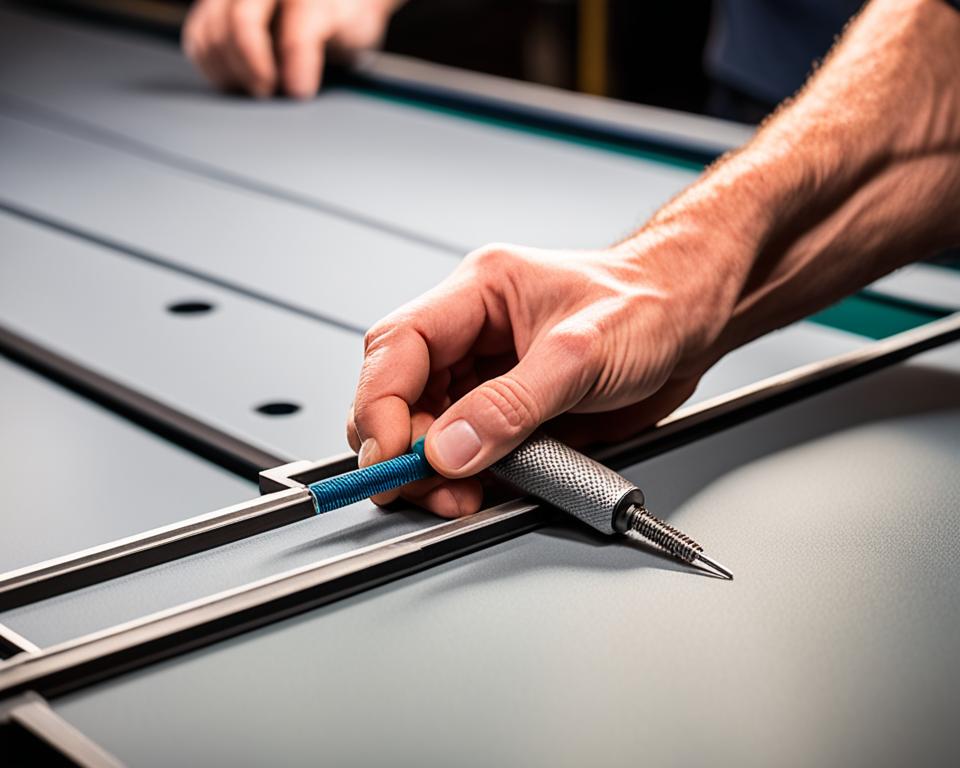Are you a novice poker player looking to take your game to the next level? Choosing the right poker table can make all the difference in enhancing your playing experience and improving your chances of success. Whether you’re a new player or someone who is just starting to explore the world of poker, it’s important to understand the various factors to consider when selecting a poker table.
A poker table is not just a piece of furniture; it’s where the excitement and strategy of the game unfold. From the size and materials to the features and options, each aspect can impact your overall gameplay. In this comprehensive guide, we will walk you through everything you need to know about choosing the right poker table for novices.
Key Takeaways:
- Choosing the right poker table is crucial for beginners.
- Consider the size, materials, features, and options when selecting a table.
- Understanding the basics of poker and choosing the right game are important factors.
- Poker table railings should be comfortable and aesthetically pleasing.
- Developing poker skills, like reading opponents, is essential for success.
Understanding the Basics of Poker
Before diving into choosing a poker table, it’s essential for beginners to have a solid understanding of the basics of poker. This includes familiarizing themselves with hand combinations, betting strategies, and game strategies. By mastering these fundamentals, beginners can make more informed choices when selecting a poker table and improve their chances of success.
When it comes to poker, knowing the different hand combinations is crucial. From a high card to a royal flush, understanding the ranking and value of each hand allows players to make smart decisions during gameplay. By studying hand combinations, beginners can quickly assess the strength of their own hand and anticipate what their opponents might be holding.
Equally important is gaining a grasp of betting strategies. Whether it’s knowing when to check, bet, raise, or fold, understanding the intricacies of betting can significantly impact a player’s chances of winning. By employing effective betting strategies, beginners can bluff their opponents or extract the maximum value from their strong hands.
Game strategies are another crucial aspect of poker. This includes understanding concepts such as position, pot odds, implied odds, and reading opponents. By mastering these strategies, beginners can navigate through different situations and make optimal decisions that maximize their chances of winning.
Hand Combinations
“Understanding hand combinations is like having the ability to read the invisible language of poker.”
Mastering hand combinations is like unlocking the secrets of the game. Here are the basic hand combinations in poker, ranked from highest to lowest:
- Royal Flush: Ace, King, Queen, Jack, and Ten of the same suit.
- Straight Flush: Five consecutive cards of the same suit.
- Four of a Kind: Four cards of the same rank.
- Full House: Three cards of the same rank and two cards of another rank.
- Flush: Five cards of the same suit, not in consecutive order.
- Straight: Five consecutive cards of different suits.
- Three of a Kind: Three cards of the same rank.
- Two Pair: Two sets of two cards of the same rank.
- One Pair: Two cards of the same rank.
- High Card: The highest-ranking card in the hand.
Betting Strategies
“Betting strategies separate the novices from the professionals at the poker table.”
Effective betting strategies can make or break a player’s game. Here are some commonly used betting strategies:
- Aggressive Betting: Making large bets and raises to intimidate opponents and extract value from strong hands.
- Conservative Betting: Making small bets to minimize losses and control the pot.
- Bluffing: Betting or raising with a weak hand to make opponents fold stronger hands.
- Value Betting: Betting with a strong hand to extract maximum value from opponents.
- Slow Playing: Betting or raising with a strong hand to trap opponents into making bigger bets.
Game Strategies
“Mastering game strategies is like having a roadmap to victory at the poker table.”
Honing game strategies is essential for consistent success in poker. Here are some key game strategies to consider:
- Position Play: Understanding the advantages of playing in different positions at the table and adjusting betting strategies accordingly.
- Pot Odds: Evaluating the ratio of the current pot size to the cost of a contemplated call to determine the probability of winning.
- Implied Odds: Factoring in potential future bets and returns when assessing the value of a hand.
- Reading Opponents: Observing opponents’ behavior, gestures, and betting patterns to gain insight into the strength of their hands.
By mastering the basics of poker, including hand combinations, betting strategies, and game strategies, beginners can enhance their decision-making abilities and increase their chances of success. Armed with this knowledge, novices can move on to the next step in their poker journey: choosing the right poker table.
Choosing the Right Poker Game
When it comes to choosing a poker game, beginners should consider options that are beginner-friendly and provide a solid foundation for their poker journey. Two popular variations that fit these criteria are Texas Hold’em and Omaha.
Texas Hold’em is widely recognized as the most popular poker game worldwide. Its straightforward rules and easy-to-understand gameplay make it an excellent choice for novice players. In this game, each player receives two private cards and uses them, along with the five community cards, to form the best possible five-card hand. The objective is to make the highest-ranking hand and win the pot.
“Texas Hold’em is a great choice for beginners due to its simplicity and widespread popularity.” – Poker Pro
Omaha is another beginner-friendly poker game that offers a similar structure to Texas Hold’em. The key difference is that in Omaha, players are dealt four private cards instead of two. However, they must use exactly two of their private cards and three of the community cards to create their hand. This variation adds an extra layer of strategy and excitement to the game.
Before selecting a poker game to play, beginners should consider their preferences and skill level. Texas Hold’em and Omaha are both excellent choices for beginners, but the decision ultimately depends on personal preference. Some players may enjoy the simplicity of Texas Hold’em, while others may prefer the strategic elements of Omaha.
By choosing a game that aligns with their interests and skill level, beginners can have a more enjoyable and rewarding poker experience.
Tips for Choosing the Right Poker Game for Beginners
- Understand the rules: Take the time to learn the rules of the game you’re interested in playing. Familiarize yourself with the hand rankings, betting structure, and gameplay mechanics.
- Start with simpler games: If you’re completely new to poker, it’s recommended to start with simpler games like Texas Hold’em. These games have well-established rules and strategies that are easier to grasp for beginners.
- Consult poker guides and resources: There are many resources available, including books, online articles, and tutorial videos, that can provide valuable insights and guidance for beginners. Take advantage of these resources to enhance your understanding of the game.
- Practice reading the game: Developing the ability to read your opponents and make informed decisions is crucial in poker. Practice observing the gameplay, analyzing betting patterns, and identifying potential tells to improve your overall strategy.
By following these tips and considering your preferences, skill level, and the gameplay dynamics, you can choose the right poker game that suits your playing style and helps you grow as a player.
Poker Table Size and Shape Considerations
When it comes to choosing a poker table, beginners should carefully consider the size and shape of the table. These factors play a significant role in creating a comfortable and enjoyable playing experience. Whether you’re hosting a game night or heading to a casino, selecting the right table size and shape is essential. Let’s explore the different options available.
Oval Table
The oval table is the most common choice for poker games. It provides ample space and can comfortably accommodate up to 10 players. The elongated shape allows players to have enough room to play their hands and place their chips. The oval design also creates a sense of unity, bringing everyone closer together and fostering a social atmosphere during the game.
Octagon Table
The octagon table is another popular option for poker enthusiasts. It typically seats around eight players, making it ideal for smaller games. The eight-sided shape provides each player with enough space to play comfortably while still maintaining an intimate setting. The octagon table is perfect for casual get-togethers or when space is limited.
Kidney-Shaped Table
The kidney-shaped table is a unique choice that is often found in casinos. It features a cut-out section on one side, providing space for the dealer to sit or stand. This design allows for easy access to the table and enhances the flow of the game. While kidney-shaped tables may not be as common for home games, they can add a touch of elegance and authenticity to your poker experience.
When choosing a poker table, novices should consider their playing needs and the available space. If you frequently host larger games, an oval table might be the best option. For smaller gatherings or limited space, an octagon table is a practical choice. And if you want to recreate the casino ambiance, a kidney-shaped table could be just what you’re looking for. By selecting the right size and shape, you can ensure that everyone has enough room to play and enjoy the game to the fullest.
Materials for Poker Table Railings
The poker table railing, also known as the padded rail, is an essential component of any poker table. It not only provides comfort for players during long gaming sessions but also enhances the overall aesthetics of the table. When choosing materials for the railings, beginners have several options to consider.
Wood for the Base
For the base of the railings, wood is a popular choice among poker table enthusiasts. It offers durability and stability, ensuring that the railings can withstand regular use. Hardwoods such as oak and maple are commonly used due to their strength and ability to withstand wear and tear.
High-Density Foam for Padding
When it comes to padding the railings, high-density foam is the ideal material. It provides ample cushioning, making the poker table comfortable for players to lean on during gameplay. The foam should be thick enough to offer support but not too soft, ensuring a balanced level of comfort.
Vinyl for the Covering
Vinyl is the go-to material for covering the railings due to its versatility and durability. It comes in a variety of colors and finishes, allowing beginners to customize the look of their poker table. Vinyl is easy to clean and maintain, ensuring that the railings stay in excellent condition for years to come.
By choosing wood for the base, high-density foam for padding, and vinyl for the covering, beginners can create poker table railings that are both functional and visually appealing.
| Materials | Advantages |
|---|---|
| Wood | Durable and stable |
| High-Density Foam | Comfortable and supportive |
| Vinyl | Customizable and easy to clean |
Assembly and Installation of Poker Table Railings
Proper assembly and installation of the poker table railings are crucial for a professional appearance. Beginners can follow the woodworking techniques outlined below to ensure a sturdy base for the railings and achieve a seamless installation.
Woodworking Techniques for the Railing Base
To begin, gather the necessary materials:
- Wood boards
- Screws
- Wood glue
- Drill
Follow these steps:
- Measure and cut the wood boards to the desired length for the railings.
- Position the boards along the perimeter of the poker table.
- Pre-drill holes into the wood to prevent splitting.
- Apply wood glue to the joints and secure them with screws.
- Allow the glue to dry completely before proceeding to the next step.
Attaching the Foam Padding
Next, beginners should securely attach the foam padding to the wood base using adhesive. The foam padding provides cushioning for players and enhances comfort during gameplay.
Follow these steps:
- Measure and cut the foam padding to match the dimensions of the wood base.
- Apply adhesive evenly to the wood base.
- Press the foam padding firmly onto the wood base, ensuring it adheres evenly.
- Allow the adhesive to dry completely before moving on to the next step.
Stretching and Stapling the Vinyl Covering
The final step is to stretch and staple the vinyl covering onto the foam padding. The vinyl covering provides a clean and professional finish to the poker table railings.
Follow these steps:
- Measure and cut the vinyl covering, leaving enough excess material for stretching.
- Lay the vinyl covering over the foam padding, ensuring it covers the entire railing.
- Starting from one end, pull the vinyl covering taut and staple it to the underside of the wood base.
- Continue stretching and stapling the vinyl covering along the railing, ensuring it remains smooth and wrinkle-free.
- Trim any excess vinyl covering for a clean finish.
Attention to detail and precision in each step of the process will result in a professionally assembled and installed poker table railing.

Developing Poker Skills and Strategy
To succeed in poker, beginners need to develop their skills and strategies. This involves mastering the art of reading opponents, effectively bluffing, and making calculated decisions. It’s essential for novice players to dedicate time and effort to improve their poker abilities, as it can significantly enhance their playing experience and success at the table.
One of the key aspects of developing poker skills is learning how to read opponents. By observing their behavior, body language, and betting patterns, players can gain valuable insights into their opponents’ hands and strategies. This skill allows them to make more informed decisions and adjust their own gameplay accordingly. Learning to read opponents takes time and practice, but it can greatly elevate a player’s performance at the table.
“Poker is a game of people. It’s not the hand that I hold, it’s the people that I play with.” – Doyle Brunson
Bluffing is another important component of poker strategy. Skilled players know how to effectively bluff, making their opponents believe they have a stronger hand than they actually do. Bluffing can be a powerful tool when used strategically, but it requires careful judgment and an understanding of the game dynamics. Novice players should study bluffing techniques and practice them in low-stakes games to gain confidence and mastery.
In the pursuit of developing poker skills and strategy, beginners should utilize the abundance of resources available. Books written by professional players, informative articles, and online forums can provide invaluable insights and advice. These resources offer guidance on various aspects of poker, including hand rankings, advanced strategies, and mental game techniques. By studying and implementing these resources, novice players can expedite their learning curve and improve their overall gameplay.
It’s important for beginners to note that developing poker skills and strategy is an ongoing process. Continual practice and self-reflection are necessary to refine and adapt playing techniques. Participating in friendly home games or low-stakes online tournaments provides valuable opportunities for practice and experimentation.
By dedicating time to implement effective strategies, improve poker skills, and take advantage of available resources, beginners can enhance their playing experience and increase their chances of success at the poker table.
The Importance of Reading Opponents at the Poker Table
One of the crucial skills in poker is the ability to read opponents at the poker table. Beginners should pay close attention to their opponents’ gestures, facial expressions, and betting patterns, as these can provide clues about their hands and strategies.
Observing opponents and assessing probabilities can help beginners make better decisions and increase their chances of winning. By understanding the subtle poker tells that opponents may unknowingly display, beginners can gain an advantage in the game.
“Reading opponents is like deciphering a unique language at the poker table. It involves keen observation, psychological analysis, and a bit of intuition. Mastering this skill can make all the difference in your poker journey.” – Pro Poker Player
Carefully observing the actions of opponents can reveal valuable information, such as whether they are bluffing or holding strong hands. For instance, if an opponent suddenly displays nervous gestures or avoids eye contact, it may indicate a weak hand or an attempt to deceive other players. Likewise, aggressive betting patterns might indicate a strong hand, while hesitant betting could signal uncertainty or a bluff.
Being able to accurately assess the probabilities of different outcomes based on opponents’ actions and available information is also vital. By analyzing the size of bets, the sequencing of bets, and the overall context of the game, beginners can make more informed decisions on when to fold, call, or raise.
Key Points:
- Reading opponents is a crucial skill in poker.
- Observing opponents’ gestures, facial expressions, and betting patterns provides valuable clues.
- Poker tells can reveal opponents’ intentions and help beginners make better decisions.
- Analyzing probabilities based on opponents’ actions is essential for strategic gameplay.
By honing these reading skills and practicing observation and analysis, beginners can gain a competitive edge at the poker table and increase their chances of success.

Tips for Choosing the Right Poker Game for Beginners
Choosing the right poker game is essential for beginners who are just starting out in the thrilling world of poker. By selecting a game that suits their preferences and skill level, beginners can enhance their overall poker experience and increase their chances of success. Here are some helpful tips for choosing the right poker game:
- Understand the rules: Before diving into any poker game, it’s important for beginners to take the time to understand the rules. Each poker game has its own set of rules and nuances, so it’s essential to familiarize yourself with them before getting started.
- Start with simpler games: For beginners, it’s best to start with simpler poker games that are easy to learn and play. Texas Hold’em, for example, is a popular choice for novice players as it offers a good balance of simplicity and strategy.
- Consult poker guides and resources: There are many poker guides and resources available online that provide valuable insights and strategies for different poker games. Beginners can benefit from studying these resources to gain a deeper understanding of the game and improve their skills.
- Practice reading the game: Developing the ability to read the game and predict your opponents’ moves is a crucial skill in poker. Beginners can practice reading the game by observing other players, analyzing their betting patterns, and paying attention to their body language and facial expressions.
Example of a Quote:
“Choosing the right poker game is like finding the perfect fit. Beginners should start with games that they feel comfortable with and gradually progress to more complex variations as they gain experience and confidence.” – Poker Pro
By following these tips, beginners can make informed decisions when choosing the right poker game to play. Understanding the rules, starting with simpler games, consulting poker guides, and practicing reading the game will not only enhance a beginner’s playing experience but also set them on the path to becoming a skilled and successful poker player.
| Poker Game | Complexity Level | Popular Variations |
|---|---|---|
| Texas Hold’em | Beginner-Friendly | Limit, No-Limit, Pot-Limit |
| Omaha | Intermediate | Omaha Hi-Lo, Pot-Limit Omaha |
| 7-Card Stud | Intermediate | 7-Card Stud High, 7-Card Stud Hi-Lo |
| 5-Card Draw | Intermediate | Basic 5-Card Draw |
Conclusion
Choosing the right poker table for novices is a crucial step in improving their game. By carefully considering factors such as table size, materials, and features, beginners can create a comfortable and suitable playing environment that enhances their overall poker experience.
In addition to selecting the right table, it is equally important for novices to develop their poker skills and understanding of the basics. By familiarizing themselves with hand combinations, betting strategies, and game techniques, beginners can make more informed choices when seated at the poker table.
Furthermore, choosing the right poker game is essential for novices to grow their skills and knowledge in a beginner-friendly environment. Games like Texas Hold’em and Omaha offer a solid foundation for beginners to learn and progress.
In conclusion, by following this guide and incorporating the strategies mentioned, novices can make informed decisions when selecting a poker table, improve their game, and elevate their overall poker experience.
FAQ
What factors should a novice consider when choosing a poker table?
Novices should consider factors such as table size, materials, features, and options when choosing a poker table.
What are some beginner-friendly poker games?
Texas Hold’em and Omaha are popular beginner-friendly poker games that are relatively easy to learn.
What size and shape of poker table should a novice choose?
Novices should choose a poker table size and shape that suits their playing needs and available space. Options include oval tables for larger games, octagon tables for smaller games, and kidney-shaped tables often found in casinos.
What materials should be used for poker table railings?
Wood is commonly used for the base, high-density foam for padding, and vinyl for the covering of poker table railings.
How should poker table railings be assembled and installed?
Beginners should follow woodworking techniques to build a sturdy base for the railings. The foam padding should be securely attached to the wood using adhesive, and the vinyl covering should be stretched and stapled for a clean finish.
How can beginners develop their poker skills and strategies?
Beginners can develop their poker skills and strategies by utilizing resources such as books, articles, and online forums that provide valuable information. Practicing and dedicating time to improving poker abilities is also crucial.
What is the importance of reading opponents at the poker table?
Reading opponents at the poker table involves paying close attention to their gestures, facial expressions, and betting patterns. This can provide clues about their hands and strategies, helping beginners make better decisions and increase their chances of winning.
What tips can help beginners choose the right poker game?
Beginners should start with simpler games like Texas Hold’em, understand the rules, consult poker guides and resources, and practice reading the game and observing opponents to enhance their understanding and skill level.





